Differences Between Different Enclosure Types
There are four major types of enclosures that are seen in car audio. Infinite baffle (or Free-Air), sealed, ported (aka vented),and bandpass.
Infinite baffle enclosures aren't really enclosures. They're simply a way to separate the front wave of the speaker from the rear wave of the speaker. A good example of this would be installing a subwoofer in the rear deck of a car. The front wave of the speaker is isolated from the rear wave of the speaker by the rear deck. Another example would be mounting the subwoofer to a board that mounts behind the rear seat of a car. The front wave pushes into the seat back and the rear wave is isolated in the trunk. For this reason it is very important that the mounting board be sealed on all edges and that the rear deck not have any holes that would allow air leakage of the rear wave into the passenger compartment. In both cases the trunk of the car acts as the enclosure which is why infinite baffle configurations are only practical in cars with trunks.
Make sure that the speaker you choose for this application is designed for infinite baffle applications or you'll get unpredictable results. Also make sure that you place a protection baffle such as an XTC foam baffle (available at Parts Express, Crutchfield and some shops) under your rear deck speakers. Otherwise the subwoofer will be overdriving the small cone of the rear deck speaker which causes massive distortion. This goes for any rear deck mounted speaker with a subwoofer system in the trunk. The baffle will isolate the speaker's rear wave from the subwoofer's high pressure wave.
The main advantage of the infinite baffle system is space savings (no box) while the disadvantages are lower power handling and inefficiency (they don't play as loud as a comparable enclosed subwoofer). I've used infinite baffles in several installations and have had mostly good success.
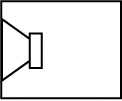 Sealed enclosures are the second least complicated and what I recommend beginners build. They are simply what the sound like, a simple box with a hole for the woofer to mount in. The rear wave and front wave are sealed from each other by the enclosure. Sealed boxes have great power handling, low frequency extension, and are known for sounding "tight". Sealed enclosures are the real workhorse of the industry and work in just about every situation and vehicle.
Sealed enclosures are the second least complicated and what I recommend beginners build. They are simply what the sound like, a simple box with a hole for the woofer to mount in. The rear wave and front wave are sealed from each other by the enclosure. Sealed boxes have great power handling, low frequency extension, and are known for sounding "tight". Sealed enclosures are the real workhorse of the industry and work in just about every situation and vehicle.
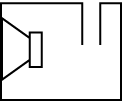 Ported (also called vented, tuned or bass reflex) enclosures are similar to sealed enclosures except they add a port or vent (typically a length of PVC pipe) to the enclosure design. Vented boxes are only slightly more difficult to build than a sealed box but must be "tuned" with the right area (diameter) and length of port for the enclosure/woofer combination. This is usually not a problem as the woofer manufacturer typically supplies this information. The function of the port is to "tune" the enclosure so that the rear wave of the speaker enhances the front wave of the speaker. This typically results in a woofer system with a higher efficiency (it plays louder with less power). The disadvantages of this design are lower power handling and poor response below the port tuning frequency. Like sealed boxes, vented enclosures also work in about every situation and vehicle.
Ported (also called vented, tuned or bass reflex) enclosures are similar to sealed enclosures except they add a port or vent (typically a length of PVC pipe) to the enclosure design. Vented boxes are only slightly more difficult to build than a sealed box but must be "tuned" with the right area (diameter) and length of port for the enclosure/woofer combination. This is usually not a problem as the woofer manufacturer typically supplies this information. The function of the port is to "tune" the enclosure so that the rear wave of the speaker enhances the front wave of the speaker. This typically results in a woofer system with a higher efficiency (it plays louder with less power). The disadvantages of this design are lower power handling and poor response below the port tuning frequency. Like sealed boxes, vented enclosures also work in about every situation and vehicle.
The last major type of enclosure is the bandpass enclosure. A bandpass enclosure come in two varieties, single reflex and dual reflex. Single reflex enclosures contain a woofer in a sealed box with a vented box in front of it. Dual reflex enclosures contain a woofer in a vented box with another vented box in front of it. In either design the woofer is hidden/protected by the front box.
Single reflex
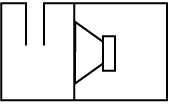
Double reflex
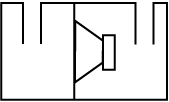
Bandpass enclosures are extremely efficient in the band of frequencies that they are tuned to or "pass" (hence the term bandpass). Disadvantages of this design are a limited frequency range, enclosure size and limited power handling. These enclosures are VERY difficult to build and are best left to the professionals. The slightest miscalculation or measurement can have seriously bad results. These boxes are usually larger and so are better for vehicles with a large amount of space.
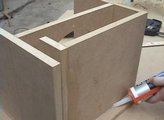
You should also check out Advanced Enclosure Design and Fabrication. It covers designing enclosures using free computer software, maximizing the output of a subwoofer system, building the box like a pro and testing the output using inexpensive equipment. Click here.
Back to the Newsletter Archives Index